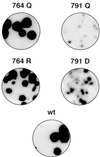Maturation of the hepatitis A virus capsid protein VP1 is not dependent on processing by the 3Cpro proteinase
- PMID: 10400711
- PMCID: PMC112698
- DOI: 10.1128/JVI.73.8.6220-6227.1999
Maturation of the hepatitis A virus capsid protein VP1 is not dependent on processing by the 3Cpro proteinase
Abstract
Most details of the processing of the hepatitis A virus (HAV) polyprotein are known. Unique among members of the family Picornaviridae, the primary cleavage of the HAV polyprotein is mediated by 3Cpro, the only proteinase known to be encoded by the virus, at the 2A/2B junction. All other cleavages of the polyprotein have been considered to be due to 3Cpro, although the precise location and mechanism responsible for the VP1/2A cleavage have been controversial. Here we present data that argue strongly against the involvement of the HAV 3Cpro proteinase in the maturation of VP1 from its VP1-2A precursor. Using a heterologous expression system based on recombinant vaccinia viruses directing the expression of full-length or truncated capsid protein precursors, we show that the C terminus of the mature VP1 capsid protein is located near residue 764 of the polyprotein. However, a proteolytically active HAV 3Cpro that was capable of directing both VP0/VP3 and VP3/VP1 cleavages in vaccinia virus-infected cells failed to process the VP1-2A precursor. Using site-directed mutagenesis of an infectious molecular clone of HAV, we modified potential VP1/2A cleavage sites that fit known 3Cpro recognition criteria and found that a substitution that ablates the presumed 3Cpro dipeptide recognition sequence at Glu764-Ser765 abolished neither infectivity nor normal VP1 maturation. Altered electrophoretic mobility of VP1 from a viable mutant virus with an Arg764 substitution indicated that this residue is present in VP1 and that the VP1/2A cleavage occurs downstream of this residue. These data indicate that maturation of the HAV VP1 capsid protein is not dependent on 3Cpro processing and may thus be uniquely dependent on a cellular proteinase.
Figures





Similar articles
-
Analysis of deletion mutants indicates that the 2A polypeptide of hepatitis A virus participates in virion morphogenesis.J Virol. 2002 Aug;76(15):7495-505. doi: 10.1128/jvi.76.15.7495-7505.2002. J Virol. 2002. PMID: 12097562 Free PMC article.
-
Identification and site-directed mutagenesis of the primary (2A/2B) cleavage site of the hepatitis A virus polyprotein: functional impact on the infectivity of HAV RNA transcripts.Virology. 1995 Oct 20;213(1):213-22. doi: 10.1006/viro.1995.1561. Virology. 1995. PMID: 7483265
-
Proteinase 3C-mediated processing of VP1-2A of two hepatitis A virus strains: in vivo evidence for cleavage at amino acid position 273/274 of VP1.J Virol. 1997 Apr;71(4):3288-92. doi: 10.1128/JVI.71.4.3288-3292.1997. J Virol. 1997. PMID: 9060697 Free PMC article.
-
[Current research on picornavirus 3C protease].Bing Du Xue Bao. 2014 Sep;30(5):579-86. Bing Du Xue Bao. 2014. PMID: 25562970 Review. Chinese.
-
Hepatitis A virus proteins.Intervirology. 1999;42(2-3):63-8. doi: 10.1159/000024967. Intervirology. 1999. PMID: 10516462 Review.
Cited by
-
Processing of the VP1/2A junction is not necessary for production of foot-and-mouth disease virus empty capsids and infectious viruses: characterization of "self-tagged" particles.J Virol. 2013 Nov;87(21):11591-603. doi: 10.1128/JVI.01863-13. Epub 2013 Aug 21. J Virol. 2013. PMID: 23966400 Free PMC article.
-
Inhibitor-Based Therapeutics for Treatment of Viral Hepatitis.J Clin Transl Hepatol. 2016 Sep 28;4(3):248-257. doi: 10.14218/JCTH.2016.00025. Epub 2016 Sep 25. J Clin Transl Hepatol. 2016. PMID: 27777893 Free PMC article. Review.
-
Peek-a-boo: membrane hijacking and the pathogenesis of viral hepatitis.Trends Microbiol. 2014 Feb;22(2):59-64. doi: 10.1016/j.tim.2013.10.005. Epub 2013 Nov 19. Trends Microbiol. 2014. PMID: 24268716 Free PMC article.
-
Analysis of deletion mutants indicates that the 2A polypeptide of hepatitis A virus participates in virion morphogenesis.J Virol. 2002 Aug;76(15):7495-505. doi: 10.1128/jvi.76.15.7495-7505.2002. J Virol. 2002. PMID: 12097562 Free PMC article.
-
Characterization of recombinant hepatitis A virus genomes containing exogenous sequences at the 2A/2B junction.J Virol. 2001 Feb;75(3):1414-26. doi: 10.1128/JVI.75.3.1414-1426.2001. J Virol. 2001. PMID: 11152515 Free PMC article.
References
-
- Allaire M, Chernaia M M, Malcolm B A, James M N. Picornaviral 3C cysteine proteinases have a fold similar to chymotrypsin-like serine proteinases. Nature. 1994;369:72–76. - PubMed
-
- Beard, M., L. Cohen, A. Martin, and S. M. Lemon. Unpublished data.
-
- Bergmann, E. M. Personal communication.
-
- Bergmann E M, James M N G. Proteolytic enzymes of the viruses of the family Picornaviridae. In: Dunn B, editor. Proteinases of infectious agents. San Diego, Calif: Academic Press; 1999. pp. 139–163.
Publication types
MeSH terms
Substances
Grants and funding
LinkOut - more resources
Full Text Sources

